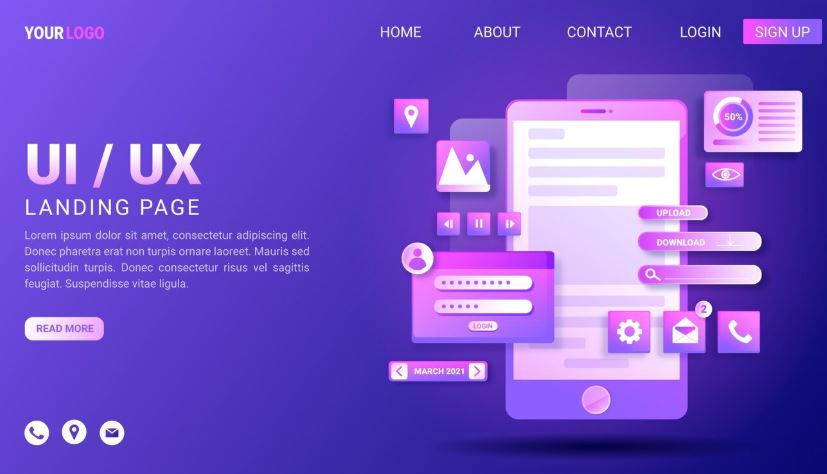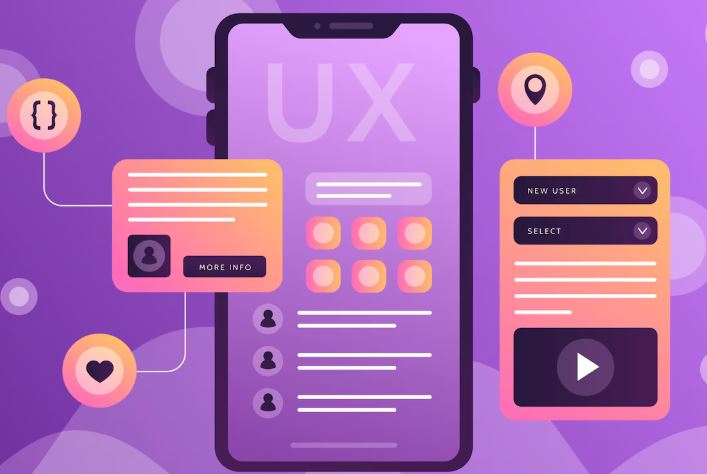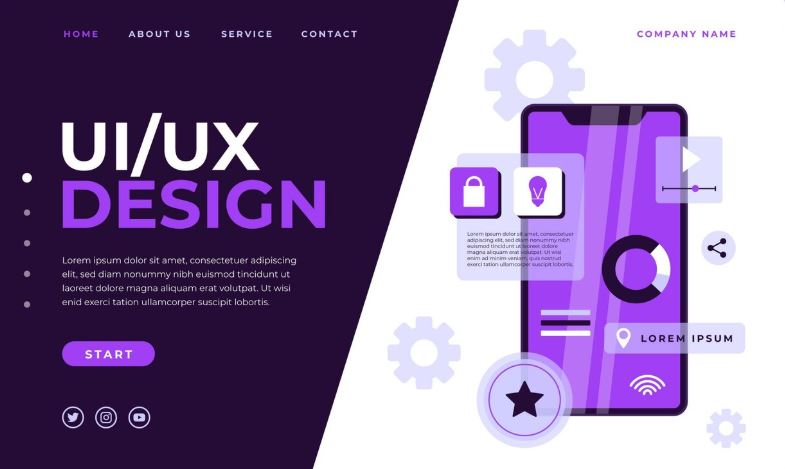What Is UX/UI Design and Why Does It Matters?
UX/UI design is the combination of user experience (UX) and user interface (UI) that shapes how people interact with a website. UX focuses on functionality, usability, and satisfaction, while UI focuses on visuals, layout, and style. Together, they create a smooth and engaging journey for users. Good UX/UI design helps websites attract, retain, and convert visitors. Here’s 7 Key Reasons Why It Matters:- Enhances overall user satisfaction
- Improves accessibility for all users
- Builds brand trust and credibility
- Guides visitors through a clear journey
- Reduces errors and confusion
- Increases conversion rates
- Encourages repeat visits

How UX/UI Design Impacts User Behavior?
A pro-designed website does more than look good; it influences how users think, feel, and act. By following 2025 web design trends, businesses can align with modern expectations, creating intuitive layouts and visually appealing interfaces. Effective UX/UI design builds a positive emotional connection, makes navigation effortless, and motivates visitors to take meaningful actions. Moreover, it keeps them engaged longer, which ultimately leads to stronger relationships and better results.
First Impressions and Emotional Response
First impressions are formed in seconds. A clean, attractive layout with choose colors and typography can instantly build trust. On the other hand, a cluttered or outdated design can turn users away. A strong visual appeal triggers positive emotions, making visitors more willing to explore further.Navigation Clarity and Reduced Frustration
Clear navigation helps users find what they are looking for without confusion. Simple menus, logical content grouping, and visible calls-to-action reduce frustration. When visitors can move smoothly from one section to another, they are more likely to stay and complete their intended actions.Guiding Users Toward Conversion Goals
UX/UI design can strategically guide users toward goals like purchasing, subscribing, or contacting. Placement of buttons, layout of forms, and visual cues lead visitors step by step toward conversion points. A perfect structure design removes barriers and makes the path to conversion intuitive.Increasing Time Spent on Site Through Engaging Design
Interactive elements, visually appealing graphics, and relevant content can keep visitors engaged for longer. The more time users spend on your site, the higher the chances they will take action or return in the future. Engaging design turns casual visitors into active participants.The Business Benefits of Good UX/UI Design
Good UX/UI design is not just about aesthetics; it directly impacts business performance. It improves conversion rates, builds loyalty, and reduces the chances of losing potential customers. By investing in professional web design services, you can achieve an optimized design that also enhances SEO performance, helping your website rank higher and attract more organic traffic.
Higher Conversion Rates and ROI
An intuitive and appealing design makes it easier for users to take desired actions, which leads to higher conversion rates. More conversions mean a better return on investment (ROI) from your marketing and development efforts.Improved Customer Satisfaction and Loyalty
When users have a pleasant experience, they are more likely to return and recommend the site to others. Consistent, user-friendly design builds loyalty over time, turning first-time visitors into long-term customers.Reduced Bounce Rates and Abandonment
A poorly designed website can cause users to leave within seconds. Good UX/UI keeps visitors engaged and reduces bounce rates by providing a smooth, enjoyable experience. This directly impacts the number of users who stay and interact with your content or services.Better Performance in SEO and Organic Rankings
Search engines consider user experience as a ranking factor. Faster load times, mobile-friendly layouts, and clear navigation help improve SEO scores. Better UX/UI design can result in higher visibility and more traffic from organic search. In below Table, you can see SEO benefits and impacts on rankings:|
UX/UI Element |
SEO Benefit |
Impact on Rankings |
|
Mobile-friendly design |
Improves mobile usability and accessibility |
Higher rankings in mobile search |
|
Fast loading speed |
Reduces bounce rates |
Positive ranking signal |
|
Clear site structure |
Helps search engines crawl effectively |
Better indexing |
| Engaging visuals and content |
Increases dwell time |
Improved user engagement metrics |
|
Accessibility features |
Expands audience reach |
Positive impact on reputation |
Key UX/UI Principles Every Website Must Follow
Strong UX/UI design follows a set of core principles that make websites both attractive and easy to use. These principles not only ensure that visitors can find what they need quickly and enjoy their experience but also answer an important question: how does website design affect sales? By following these principles, businesses create trust, keep users engaged, and ultimately drive higher conversions.
Consistency in Design Elements
Consistency makes a website feel reliable and professional. Using the same colors, fonts, and button styles across all pages helps users recognize patterns and understand how to interact. When everything feels familiar, visitors navigate more confidently and stay longer.Visual Hierarchy and Readability
Visual hierarchy guides the user’s eyes to the most important content first. Clear headings, balanced spacing, and proper font sizes improve readability. A good hierarchy ensures that visitors can scan and understand content without feeling overwhelmed.Mobile Responsiveness
Mobile responsiveness means the website works seamlessly on all devices and screen sizes. With more users browsing on smartphones, a responsive design ensures accessibility and comfort. It prevents users from leaving due to poor mobile experiences.Accessibility and Inclusive Design
Accessibility ensures that all users, including those with disabilities, can use the site effectively. Features like alt text for images, keyboard navigation, and proper contrast levels make content inclusive. Inclusive design expands your audience and improves your brand’s reputation.Common UX/UI Mistakes That Hurt Website Performance
Even small design mistakes can push visitors away. Poor UX/UI can cause frustration, reduce trust, and lower conversion rates. Avoiding these common errors is key to maintaining a healthy, high-performing website.Overloaded Pages and Confusing Layouts
Too many elements crammed into one page create visual chaos. Users struggle to find what they need and may leave immediately. A clean, organized layout makes navigation easier and reduces mental fatigue.Poor Call-to-Action Placement
CTAs should be visible and strategically placed to guide users toward desired actions. If buttons are hidden, unclear, or too far down the page, conversion opportunities are lost. Placement and wording matter for every click.Slow Page Speed and Unresponsive Elements
A slow-loading website frustrates users and increases bounce rates. Unresponsive buttons or forms make the experience worse. Speed and responsiveness are essential for keeping visitors engaged. Here’s a table that shows you crucial problems and impacts on UX:|
Problem |
Impact on Users |
Result for Website |
|
Slow loading speed |
Users leave before content appears |
Higher bounce rates |
|
Delayed interactive elements |
Frustration and reduced trust |
Fewer conversions |
|
Poor mobile responsiveness |
Difficult browsing on smaller devices |
Lost mobile audience |
|
Heavy, unoptimized visuals |
Longer load times and lag |
Lower SEO rankings |
Ignoring User Feedback
User feedback is a valuable source of improvement ideas. Ignoring it means missing opportunities to fix issues that directly affect satisfaction. Regularly gathering and acting on feedback keeps the design relevant and user-friendly.How to Evaluate and Improve Your Website’s UX/UI?
Improving UX/UI starts with understanding how people use your site. Evaluation tools, analytics, and design best practices help you spot problems and create better experiences. A continuous improvement approach ensures long-term success.Conducting Usability Tests and Heatmaps
Usability tests show how real people interact with your site, revealing pain points and areas for improvement. Heatmaps visualize where users click, scroll, or pause, helping you optimize key areas for engagement.Using Analytics to Identify UX Issues
Website analytics can highlight high bounce rates, low conversion pages, and weak engagement spots. By tracking user behavior, you can prioritize fixes that have the biggest impact on performance.Applying User-Centered Design Processes
A user-centered design process keeps the focus on the audience’s needs. From wireframes to prototypes, every step considers how users will interact. This leads to designs that feel natural and effective.Collaborating with Professional UI/UX Designers
Experienced designers bring expertise, tools, and creative solutions to the table. Partnering with professionals ensures your website not only looks appealing but also functions seamlessly across all devices and platforms.
Final Thoughts: Why UX/UI Can Make or Break Your Website
Good UX/UI design is more than just colors and fonts. It is about creating a website that looks great, works smoothly, and feels natural to use. Clear navigation, fast loading speed, and accessibility all work together to keep visitors engaged. Businesses that invest in quality design see better results in conversions, loyalty, and brand trust. If you want your website to deliver the best possible experience, now is the time to act. At HDM Agency, we combine creativity, strategy, and technology to craft designs that convert. You can start today by calling us at +971 56 26 01 368 or filling out our consultation request form. Our UAE branch is ready to help you turn your site into a powerful business tool.FAQs – Frequently Asked Questions
- What is the difference between UX and UI in website design? UX focuses on the overall user journey and usability, while UI deals with the look, style, and visual elements of the site. Both are essential for a seamless experience.
- How often should I update my website’s UX/UI design? It is recommended to review and update every 1–2 years or whenever there are significant changes in user needs, branding, or technology trends.
- Does UX/UI design affect SEO? Yes. A perfect-designed site with fast load speed, mobile responsiveness, and good navigation can improve SEO rankings and attract more organic traffic.
- How can I measure if my UX/UI design is successful? Track metrics like bounce rate, session duration, conversion rate, and user feedback to evaluate performance and identify areas for improvement.
- Can small businesses benefit from professional UX/UI design? Absolutely. Even small businesses can see higher customer satisfaction and conversion rates with a planned, user-friendly design.




